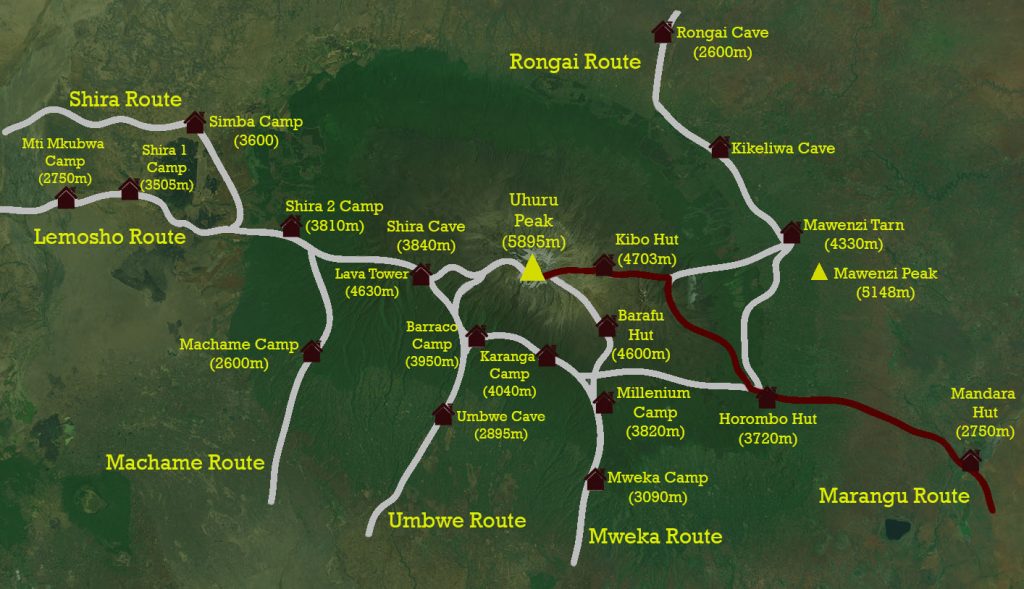ROUTES TO UHURU PEAKS
Routes to the Roof of Africa – Mount Kilimanjaro
Situated just south of the equator in Tanzania, Mount Kilimanjaro rises to an impressive 19,340 feet (5,895m). It is the tallest free-standing mountain in the world and one of the Seven Summits. A reasonable degree of fitness is usually enough for most climbers to attempt the mountain, provided that they allow enough time for proper acclimatization.
The Lemosho Route is one of the most beautiful and less-traveled approaches. Starting on the western side of Kilimanjaro, it begins with a long drive to the trailhead but rewards climbers with the chance to see wildlife on the lower slopes and walk in relative solitude during the first days. This route is perfect for those who prefer a slightly longer and more gradual ascent. It meets up with the Machame Route on the third day.
The Londorosi/Shira Route also begins on the western side, leading trekkers through pristine rainforest and onto the wide open Shira Plateau. From there, it joins the Machame Route, traversing the scenic southern side of the mountain. Although it is one of the longest routes, it is less crowded and offers spectacular views of both the Shira Plateau and the dramatic Western Breach Wall.
The Marangu Route is the most traditional and straightforward path up Kilimanjaro. Often referred to as the “Coca-Cola Route,” it is the only route that provides hut accommodation instead of camping. The Marangu trail follows the same path up and down and is considered one of the easier hikes. Typically taking five days to complete, this route covers about eighty kilometers. We recommend choosing the five-night option for better acclimatization, especially for first-time trekkers.
The Machame Route, also known as the “Whiskey Route,” is one of the most popular and scenic climbs. Approaching from the south-west, it takes climbers through the stunning Shira Plateau, past the dramatic Lava Tower, and down into the Barranco Valley. From here, hikers enjoy breathtaking views of the Kibo glaciers before making the final ascent. While this route is more challenging than Marangu, it offers a rewarding mix of adventure and scenery. An additional acclimatization night is highly recommended for novice climbers.
The Rongai Route approaches Kilimanjaro from the north, close to the Kenyan border, and retains a sense of untouched wilderness. This quieter, lesser-used route has a gentle gradient and shorter daily walking stages, making it a great choice for novice hikers. The trail passes through farmland, forest, and alpine moorland before reaching the summit cone. Along the way, trekkers enjoy sweeping views over Kenya and Mawenzi Peak before ascending to Gillman’s Point and on to Uhuru Peak.
The Umbwe Route is the shortest and steepest way to the southern glaciers and the Western Breach of Kibo. It begins with two steep days through pristine rainforest before joining higher trails. This route is physically demanding due to its fast ascent and requires good fitness levels. However, its rewards include solitude, untouched wilderness, and the possibility of spotting wildlife in the lower forests. It is a challenging but truly rewarding climb for fit and adventurous hikers.
The Northern Circuit Route is the longest trail on Kilimanjaro and one of the most rewarding. This nine-day trek begins on the western side via the Lemosho Route, leading up onto the Shira Plateau and past the Lava Tower before circling around the northern slopes in a clockwise direction. It eventually joins the Rongai Route and makes the summit push from the east, before descending via the southern Mweka Route. With a gradual ascent and plenty of acclimatization time, the Northern Circuit offers the highest success rates and panoramic 360-degree views of the mountain.









